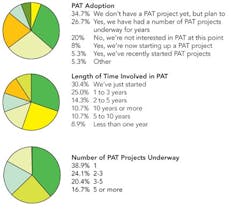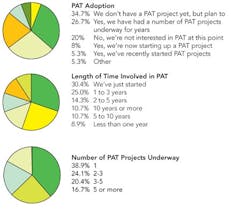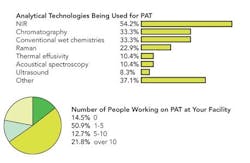First Process Control Survey Separates Early Adopters, Skeptics
By Agnes Shanley, Editor in Chief
Seventy-five professionals representing a cross-section of the industry responded to Pharmaceutical Manufacturing’s first survey on process control and automation in the drug industry, providing a snapshot of control practices at many drug companies. Some respondents work at large, global corporations and others at smaller companies (one respondent describes his facility’s computers and IT systems as “vintage 1970s” technology).
While responses, so far, aren’t statistically significant (we will be updating and expanding this survey regularly), they still offer some insight into the industry’s changing approach to process analytical technology (PAT) and process control.
Interestingly, continuous processing is not the “blasphemy” that it might have been considered a decade ago by some drug industry professionals. Although respondents indicate that its use will depend closely on the chemistry involved in the specific process, they say that improvements in hardware and software make it more feasible, and that it would assure product quality and save money.
“Continuous control offers manufacturers a competitive advantage, but, at some point, FDA and other regulators will require it, as they see more MES (Manufacturing Execution System) implementations during plant inspections,” notes one respondent. Another, acknowledging that petrochemicals and electronics manufacturers have been using the methods successfully for so long, says, “It’s about time the pharma industry follows suit. FDA will determine the role that continuous processing and control play, as the Agency provides more or less freedom to manufacturers to improve their processes, continuously.”
Another respondent who may be representative of a large number of industry professionals at this point says, “It seems that continuous process control would fit nicely with the PAT initiative, but we’re not currently working on anything like this.”
Closed to Open Control
Despite more discussion of open control standards, and some staunch supporters within the drug industry, the survey indicates that professionals at many drug companies aren’t familiar with ISA/ANSI 95 or 88. “Ignorance is bliss,” says one.
Others describe them as too difficult to apply, given the array of automation systems and the even larger number of vendors that most drug manufacturing facilities must contend with. “At most facilities, it’s a real struggle even to discuss these standards,” another says.
One respondent was candid about S88. “We have attempted to use it in the past, but will avoid it moving forward.” Says another, “Each attempt at installing this method has proven too expensive, and counterproductive.”
However, the survey indicates that more drug companies are embracing PAT. 27% indicate that they’ve had PAT projects under way for a number of years, 13% have either started PAT projects recently or are just embarking on them now. 35% aren’t using PAT but plan to, while 20% aren’t interested in PAT (see Charts below).
Roughly 40% of those using PAT have just started projects or been working on them for less than a year, one quarter have been working on PAT for one to three years. Nearly 11% have been working with PAT for 10 years or more, another 11% for five to 10 years.
Staffing and Analytics
Of that same group, 40% say their facilities have only one PAT project under way, while 20% have three to five and 17% have five or more (see Chart above). Most companies (36% of respondents) have put a multidisciplinary, cross-departmental team in charge of their PAT projects, while 30% have charged their process engineering departments with PAT.
As far as the “analytics” portion of PAT is concerned, NIR appears to be the dominant technology being applied, with 54% of respondents using it (see Chart below). Chromatography is used in one-third of respondents’ projects, and Raman in 23%. Other technologies being used include in-situ particle size measurement using FBRM, laser diffraction and online NMR.
For data analysis, most respondents aren’t using principal component analysis or partial least squares methods, although one-third are using both methods. We also asked how routinely respondents use process capability analysis and statistical process control (SPC) methods at their facilities. Most (27.5%) say that they don’t typically use either method, although 18% say that they perform both methods routinely, and an equal number perform both occasionally.
IT Infrastructures
Over half of respondents say that their facilities are using enterprise resource planning (ERP) software platforms; 17% indicate that they aren’t yet but may plan to, while 21% say they aren’t using it (see Chart at right).
Most respondents are not using manufacturing execution systems (MES) at this point, although 31% are using it and 27% plan to (see Chart at right).
We asked respondents to rank the importance of various IT and control goals (to see Table, click here). Scoring highest in the “extremely important” category were developing trending for equipment and batch manufacturing (with 28%), and improving the quality of data for equipment and batch manufacturing (with 22%).
Most highly rated in the “very important” category were integrating data from field-level sensors to the plant floor (with 45%), developing trending data for equipment and batch manufacturing (with 39%) and integrating time-series data with batch and LIMS databases (with 36%).
Staff Backgrounds and Interaction
Most of the control engineers at respondents’ plants have electrical engineering backgrounds, with one-third holding chemical engineering degrees.
The ratio of control professionals to chemists varies widely at respondents’ facilities. 31% describe it as “roughly equal,” although 24% say that it is five chemists to every two engineers and 20% place that ratio at 10 to 1 (one respondent described it as 30 to 1!).
When asked how closely, and how soon, process control specialists were involved in discussions of process design and development, 24% say that they are closely involved only at the commercial scaleup stage, but 22% describe being involved “almost as an afterthought,” suggesting that interactions earlier in the drug development cycle might be beneficial. However, some companies are already moving in this direction. 16% describe process control specialists as involved from the very start, with 13% saying that they’re involved very closely, at Phase III or sooner.
IT and Control Cultures
Since IT and automation are so closely integrated today, we asked how closely pharma automation and IT teams work together and communicate. 29% of respondents describe such communication as “frequent,” and 16%, “as often as possible.” However, 36% say that the two worlds seldom or rarely work together, and 18% describe them as being “on different wavelengths.”
Open Control Standards
The open process control standards ANSI/ISA 95 and 88 have become increasingly important in a number of manufacturing sectors, so we asked about them to get some idea of how pharmaceutical companies are using them. As far as 95 is concerned, a whopping 32% of respondents have never heard of it, and another 34% say that it isn’t all that important. 27% say that it is fairly important while 5% describe it as underlying everything they do (see Chart below).
88 has more supporters. 38% of respondents say they aren’t familiar with ANSI/ISA 88; 20% say they aren’t really using it, although 30% describe it as important, and 10% as critical.
Control Strategies
92% of respondents are using common control strategies, 22% are using model predictive control and 19%, advanced control (see Graph below). Half of respondents say that they aren’t yet evaluating the use of virtual sensors and advanced control for their processes, and 15% state flatly that they aren’t and don’t plan to. However, 10% are already using them for some processes, and another 25% are evaluating and plan to use them.
One often hears of alarm management in connection with petrochemical plant safety, but it is becoming an issue for pharmaceutical facilities as well. Although 30% of respondents to our survey have such a strategy in place, 35% do not. 23% say that they’re developing one, and 10% don’t have one and don’t plan to have one either. FMEA (Failure Modes and Effects Analysis) is guiding these alarm-management programs, with 60% of respondents describing it as a key tool. Hazop (Hazardous Operations) analysis is being used by 44%, and IEC 61508 by 20%.
Simulation appears to be slowly gaining ground in pharmaceutical facilities. 55% of respondents say that they are not using simulation yet. 18% say that they use it only during new facility design and plant expansions. However, 15% are using it for process operations, and 8% for facilities management. The remainder do not see it as important.
Although one-quarter of respondents have no intention of using wireless monitoring, 38% are evaluating its use for warehouse and/or process applications, and 15% for warehouse applications only.
The Future and Continuous Processing
Most respondents (60%) see continuous process control as playing a role in some processes in the future. Nearly one third are already applying it in some cases.
Real-time knowledge-based control systems (RTKBS) aren’t yet a factor, although 35% of respondents say that they will be within 20 years, and 33% describe them as becoming more widespread within the next five years. Nearly 20% say that their use is “right around the corner,” although a group of skeptics (8% of respondents) say that they don’t really exist, and wouldn’t work for drug manufacturing.
However, some respondents note a resistance to adopting these technologies. “People don’t know what is is and are both skeptical and afraid of it,” one says.
Focus and cost are major issues impeding adoption of these technologies, respondents say. “Normally, we are focused on keeping the plant running,” a respondent says. “Only recently has the focus been expanded to keeping the plant up-to-date. Using RTKBS forces you to be current in technology all the time.”











